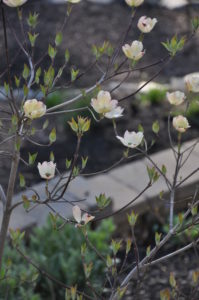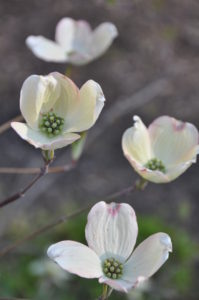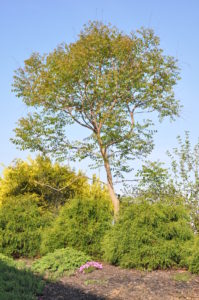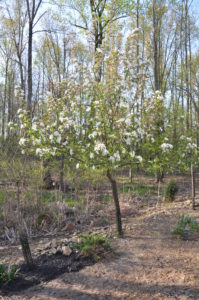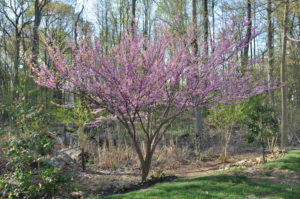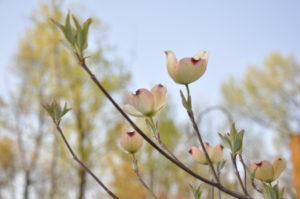Our dogwood has finally bloomed.
She withstood the travails of flood, drought and blizzard, and constant cropping by deer, and this spring she blossomed, like some insecure girl crossing that seemingly impassable divide between challenged childhood and blessed womanhood.
Her siblings, in a foster-child kind of way, were more precocious. I knew, however, that delayed efflorescence does not disallow full flower.
Back in, oh, 2004 I think it was, we made a donation to the Arbor Day Foundation and received a bag with ten twigs in it: two redbuds, two hawthorns, two crabapples, two Goldenrain trees, and two dogwoods. We carefully potted them up, watered them every few days and set the pots into a garden bed when it came time to winter over.
Somewhere along the line we lost a dogwood and a Goldenrain tree. The rest grew well, moved into larger pots, and came with us to our new home along with some volunteer hollies, lavender bushes, the bay tree, and a few other cherished plants. The saplings—they had all achieved an age one might think of as tweenhood—did well on the patio as we mulled over where they might best flourish.
The redbuds and hawthorns went in back along the edge of the woods. The crabs found a spot in the side garden and the Goldenrain tree survivor headed up front to the “yellow garden.” We weren’t sure just yet where to put the dogwood.
All was well until that morning we noticed that the Goldenrain tree had been gnawed to a nub. Okay, we said. We now know, despite assurances in various publications, Goldenrain is not “deer-resistant.”
We potted up the stump and moved it back to the patio to see if it would recover. We set the dogwood temporarily in its place. And all was well.
Eventually—a year or so down the road—we swapped the dogwood and the renewed Goldenrain tree. A new stone terrace offered the perfect location for the dogwood and I imagined bright flowers enjoying its dappled shade.
And all was well.
For a while.
The deer, having eschewed the dogwood while it was up front suddenly developed a taste for it. They also rediscovered Goldenrain, which subsequently developed severe scoliosis. Regular applications of rotten-egg spray to new leaves helped a little, but only a little.
Meanwhile, in the plantings behind the house, other problems emerged. Both redbuds initially thrived and then—without warning—one croaked. For weeks it was fine, then it went limp, turned yellow, and before a week was not only merely dead, but really most sincerely dead. The hawthorns, suffering their own deer-depredation issues, picked up a fungus that neither aggressive pruning nor fungicide has kicked. The crabapples quickly got too large for the side garden and were moved to the Lower Forty. One was large enough that most branches soon extended beyond ungulate reach. The other one? Let’s just say it has attained bonsai dimensions.
Still, we take our triumphs were we get’em.
A few years and a nip-and-prune later, the redbud has achieved a graceful branched form and offers an explosion in orchid-pink each spring. The posture of the Goldenrain tree has been corrected and in season it is all feathery-green foliage; even a few aureate blooms gleam in the summer sun. The big crabapple is Brobdinagian next to its Lilliputian cousin. The hawthorns? Meh. We should probably cut them down. They are too close to the weeping willow which went from a branch rooting in a vase of water to the glory of the back yard in about four years.
This year, nine years after we potted up that seedling and almost six years after we transplanted a sapling into the ground, Patience has given us flowers. All is well.

